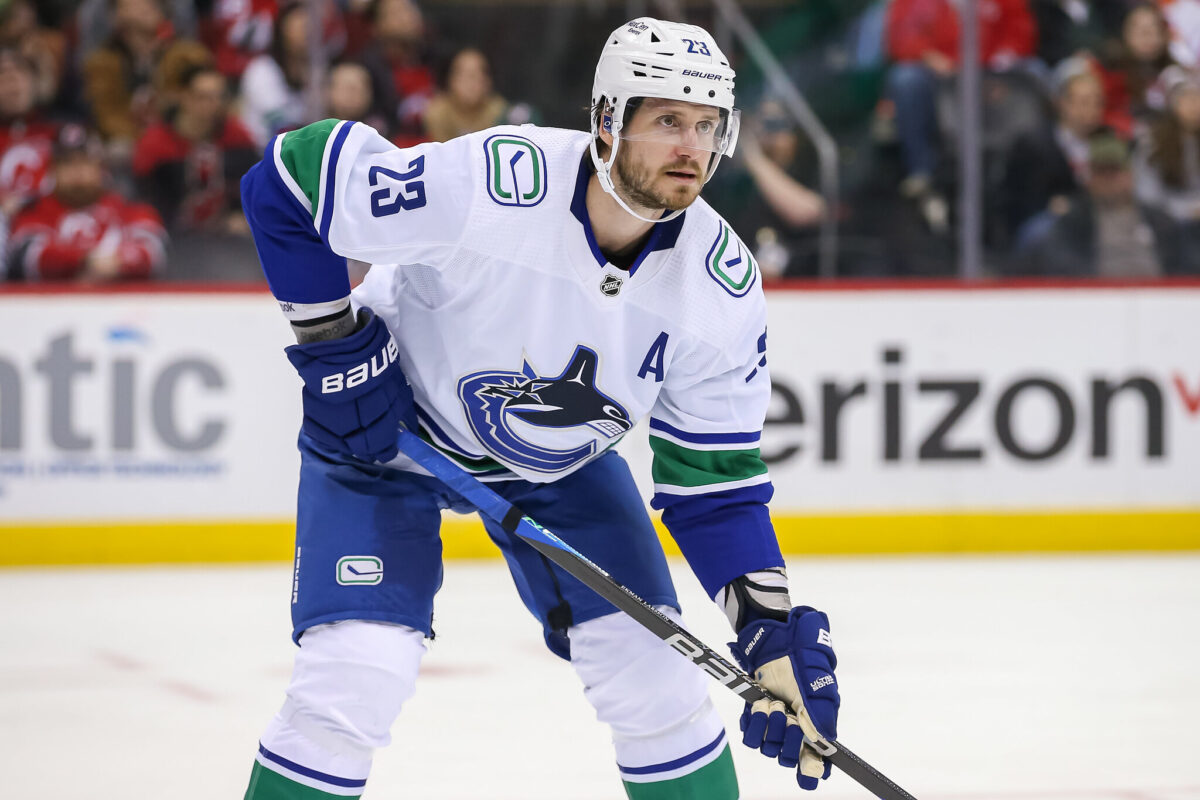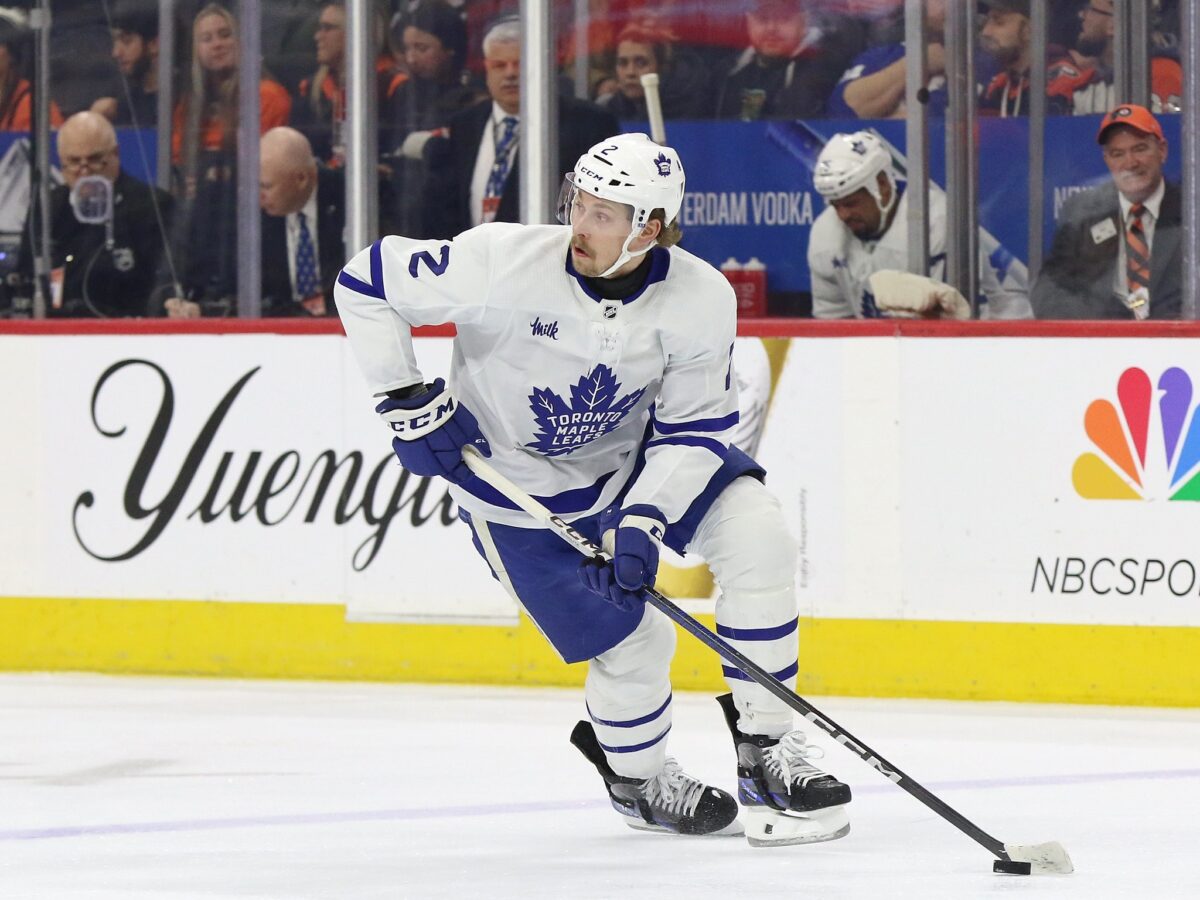Every once in a while, my friend Stan Smith sends me an email chart with numbers that give me more insight into the Toronto Maple Leafs. This week, it was another deep dive into goals for and against, the same measure we used on the forwards a few days ago.
Stan’s explanations are not layered with heat maps or expected anything. But his research is insightful, and sometimes honesty is enough to tell you who’s pulling the Maple Leafs wagon and who’s just hanging on.
Related: Maple Leafs’ Easton Cowan’s Role Isn’t the Result of Entitlement
This time, he ran the numbers on defence, and what he found wasn’t exactly surprising, but it did put some things in focus. If you’ve been wondering who’s helping and who’s hurting Toronto’s blue line, here’s how Stan’s insights help us break things down.
Maple Leafs at Even Strength: The Quiet Workhorses Rise First
These numbers are a simple way to show a player’s impact at five-on-five. Every time a player is on the ice when his team scores, he gets a plus-1. Every time he’s out there for a goal against, he receives a minus-1. Add those together and you get his overall rating. A positive number means his team scores more often with him on the ice; a negative number means the opposition scores more during his shifts. It’s not fancy, but it gives a quick snapshot of whether his minutes are helping or hurting on the scoreboard at even strength.

Four defensemen finished on the positive side of the ledger at even strength. Three of them — Oliver Ekman-Larsson (plus-7), Jake McCabe (plus-6), and Chris Tanev (plus-5) — are clearly driving the bus. Two of those players have over 300 minutes. Tanev? He’s sitting at just 110. If he’d stayed healthy, he might have led this group by a mile.
Brandon Carlo, who’s taken more heat than a June sidewalk, sits at plus-1. It’s not spellbinding, but it’s serviceable. Given the number of nights he’s spent covering for Morgan Rielly’s adventures, “serviceable” actually feels like an achievement.
Related: Maple Leafs Injury Report: Can Toronto Survive Without 7 Regulars?
Rielly himself is the puzzle. The forty-eight total goals scored when he’s been on the ice are more than anyone else, and he’s on the wrong side of it at minus-2. He looks brilliant one night, and problematic the next. You can feel Carlo paying for it in real time. That pairing is a seesaw; sometimes it balances, sometimes it whacks you in the shins.
Simon Benoit and Dakota Mermis sit together at minus-3, but Benoit’s done it over nearly 300 minutes while Mermis hasn’t even cracked 70. Both have had their bumps, and then there’s Philippe Myers at minus-7 in only 126 minutes. That’s tough sledding for a player getting mostly sheltered, third-pairing ice time.

There’s a reason Troy Stecher suited up the moment he hit waivers. One game in, one even-strength goal for, none against. Coaches notice that.
Power Play: Rielly Still Runs the Show
Rielly and Ekman-Larsson are the only two defensemen who matter on the power play (PP). McCabe’s ice time of 3:31 barely registers. Rielly’s been on for six power-play goals and one shorthanded against. Ekman-Larsson sits at 3-for-1. The ice time gap explains part of it, but the truth is the power play runs better with Rielly up top.
Related: NHL Rumors: Odd Oilers Lines, Canadiens Trade, and Maple Leafs Job Security
There’s always a caution here — power plays are fickle and matchup-dependent. What works against the Columbus Blue Jackets might die on the vine against the Vegas Golden Knights. But if you’re looking at this season’s story alone, the PP tilts Rielly’s way by a pretty comfortable margin.
Penalty Kill: This Is Where Tanev Earns His Money
Short-handed numbers are messy to judge, so Stan did the sensible thing and scaled them all down to what happens over the span of a two-minute minor. Once you normalize the ice time, Tanev comes out the best at -0.19 per penalty. Carlo and Benoit sit tied just behind him at -0.20. McCabe’s at -0.25.

Ekman-Larsson and Myers are further down the list. The opposition scores roughly a goal every three penalties killed. Not disastrous, but not what you want from your second wave.
Related: How Craig Berube Is Recasting the Maple Leafs’ Identity
Tanev is Toronto’s best penalty killer by a clear margin. Then you get a cluster of competent grinders. Then you have the players you hope don’t have to play too often.
Who’s Been the Maple Leafs’ Best Defenseman?
If you’re measuring in all situations, the answer is pretty simple: it’s Tanev. When he’s healthy, he moves the needle everywhere except the power play — and no one’s expecting him to run that anyway. The week he went down was the week the Maple Leafs looked their most brittle. That’s not a coincidence.
After him, you can make a real case for Oliver Ekman-Larsson, simply because he’s been both productive and available. Availability still matters in this league, maybe more than ever.

Third place? That’s where the argument gets more philosophical. Rielly and Carlo are tied together like two mismatched roommates. Carlo’s been slightly better at even strength; Rielly runs the power play; they both have nights you want to forget. Call it a shared bronze medal and wish they’d both clean up the sloppier parts of their games.
Fifth is Benoit — struggling at even strength, solid on the PK. At the bottom sits Myers, who’s playing his way into the “maybe we carry eight defensemen” conversation. Stecher has landed, and it looks as if he’s knocking on the door. Henry Thrun is knocking. The only thing keeping the door from swinging open is timing.
Final Thought: There’s a Good Blue Line Here — If They Ever Get Healthy
Look at the numbers one way and you see flaws. Look at them another way, and you see structure. The truth is somewhere in between. When Tanev is in the lineup, the Maple Leafs have a backbone. When Ekman-Larsson and McCabe are rolling, they look like a playoff defensive core.
Related: Ex-Maple Leafs’ Defenseman Jake Gardiner: Where Is He Now?
If Stecher settles in, and if the Rielly/Carlo tandem finds a little more stability, this blue line could end up looking deeper than people give it credit for. But as always in Toronto, health and timing will tell the real story.
For now, these numbers give us the clearest version of what’s happening beneath the surface — and what still needs to happen if this group wants to win.
